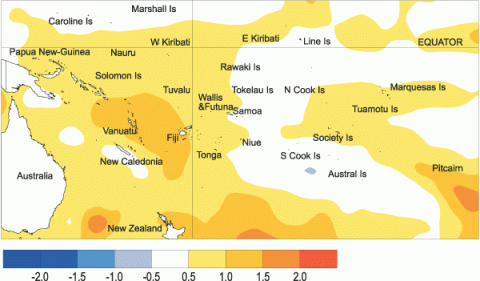ENSO and Sea Surface Temperatures
The tropical Pacific Ocean warmed rapidly during the second half of April, resulting in the resurgence of borderline El Niño conditions (which could also be described as a "neutral but in a warm" state). The Southern Oscillation Index (SOI) decreased in April to -1.3, making the February to April mean -1.6 (the 3-month mean SOI has been below -1 all of 2005 so far).
The equatorial Pacific Ocean positive subsurface temperature anomaly noted last month is now surfacing in the eastern Pacific, with SST anomalies east of the Date Line rising rapidly from mid April.
The NINO3 SST anomaly rose to about +0.4 °C in April, with NINO4 near +0.6 °C, and NINO3.4 about +0.4 °C. Surface zonal wind anomalies have become positive across the equatorial Pacific, more strongly west of the Date Line. Outgoing longwave radiation (OLR) anomalies showed a very active SPCZ in April, with suppressed convection east of the Date Line, south of the equator.
Most available models indicate neutral conditions (with positive NINO3.4 anomalies) through July 2005, and into the southern hemisphere spring. The latest US National Center for Environmental Prediction (NCEP/CPC) statement forecasts El Niño Southern Oscillation neutral conditions for the next three months. The International Research Institute on Climate Prediction (IRICP) summary describes the present situation as a neutral (but slightly warm) state, and gives a 65% chance of neutral conditions persisting through July 2005. The Australian Bureau of Meteorology says that chance of El Niño developing is about 30 to 50%, but this will rise if current trends persist.
Sea surface temperature anomalies (°C) for April 2005

Mean sea surface temperatures (°C) for April 2005

